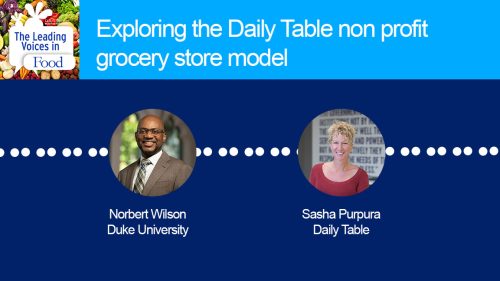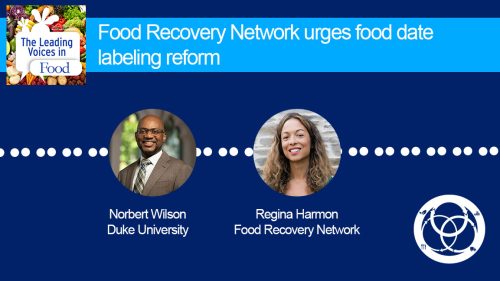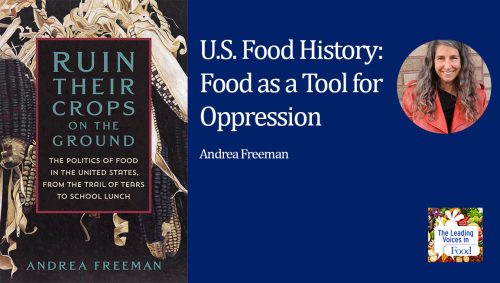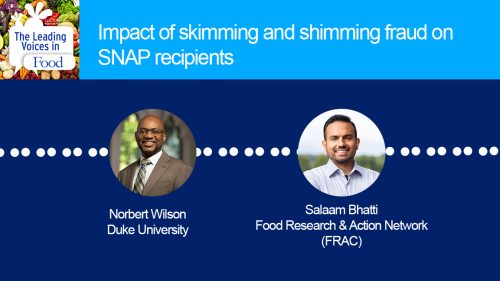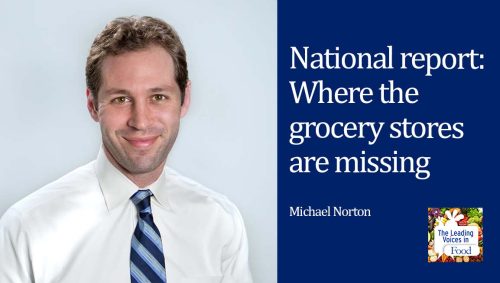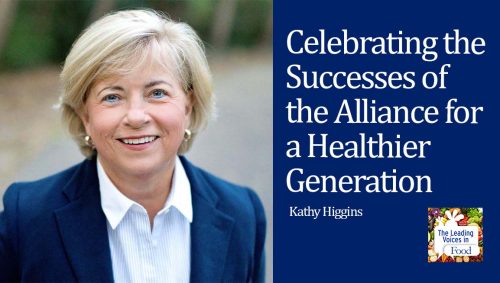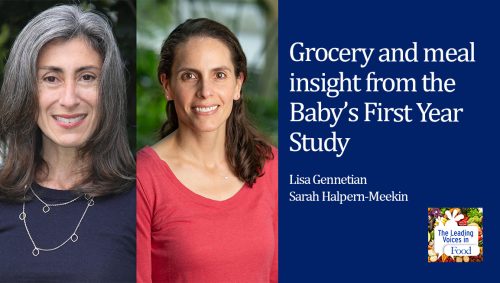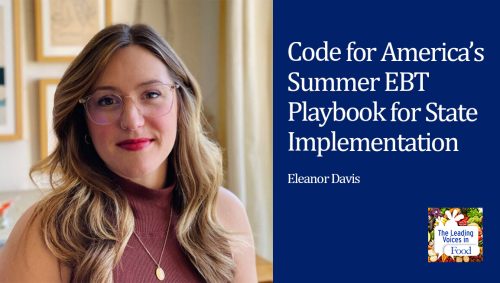E112: Food Banks, Food Pantries, and the Promise of More
Food banks and food pantries provide life-saving help for families all around the country. Like other institutions addressing food issues, there is growing focus on providing not just food, but healthy food. There are complex issues in this picture, however, issues we can address with today’s guest, Dr. Marlene Schwartz. Schwartz is director of the Rudd Center for Food Policy and Obesity and Professor of Human Development and Family Studies at the University of Connecticut.
Subscribe: Apple Podcasts | TuneIN | YouTube Music | SoundCloud | PocketCasts | Radio Public
Tags: Food Banks, Food Pantries & Soup Kitchens | Food Insecurity | Food Policy | Philanthropy & Food Systems | Social Safety Net & Food |

Dr. Marlene Schwartz is Director for the Rudd Center for Food Policy & Obesity and Professor of Human Development and Family Sciences. Dr. Schwartz’s research and community service address how home environments, school landscapes, neighborhoods, and the media shape the eating attitudes and behaviors of children. Schwartz earned her PhD in Psychology from Yale University in 1996. Prior to joining the Rudd Center, she served as Co-Director of the Yale Center for Eating and Weight Disorders from 1996 to 2006. She has collaborated with the Connecticut State Department of Education to evaluate nutrition and physical activity policies in schools and preschools throughout the state. She co-chaired the Connecticut Obesity Task Force and has provided expert testimony on obesity-related state policies. She also serves on the Board of Directors of the Connecticut Food Bank.
Interview Summary
Many of our listeners will know in general how food banks work, but may not know the details. Can you explain in general how these organizations operate? Where do they get their food and where does it go?
There are two terms that you hear a lot: food bank and food pantry. So a food bank is basically a huge warehouse that will get food either directly from a factory, from the food industry, or from a large retailer, sometimes directly from farmers and then sometimes from food drives or other efforts to collect food to donate. Most food banks have an online ordering system for food pantries, so food pantries are much smaller. They are sometimes run by churches or other community centers, and they’re typically fairly small places where the staff will obtain the food from the food bank and maybe some also in addition from other local retailers or donations, and then that’s where the clients come in. And so the clients will go to the food pantry in their community and that’s where they will obtain the food that they can then take home and use.
If there are other programs that help people with food-related needs like SNAP and WIC, how do food banks fit into this overall picture?
So, it’s really interesting because when you look at the actual amount of food provided by certainly a program as large as SNAP or WIC, food banks are tiny by comparison. So it’s really a very, very small percentage of food that individuals get from the charitable food system compared to SNAP and WIC. However, I think their role really goes beyond the food they provide. Oftentimes food pantries are a place where people can come and get access to other resources in their community. So as I mentioned, they’re often in community centers or faith-based organizations that will not only provide the food, but sometimes provide assistance signing up for SNAP or WIC or finding out about other types of social services or resources that are in the community. And so I think that their role can really be measured not just by the amount of food that they distribute, but also the way in which they connect their clients with other resources and really provide a place of support for their community.
You’ve paid a lot of attention to using the healthiness of the food distributed as an index of success. So how’s this different than what’s been done traditionally?
Traditionally, the success of food banks or food pantries has been measured in the pounds of food. And it’s really interesting because you can see why that was an attractive measure because it’s super easy. You basically just put the food on a scale, you measure how many pounds it is, it’s a number, you know when it’s more or less, and it’s pretty straightforward. But as often happens when things get measured is that sometimes the system evolves to really maximize the measure without thinking about the consequences. So really heavy products, like two liter bottles of soda, for example, became very popular to donate to food banks and food pantries because they weighed a lot. And other things like maybe a container of spinach or kale was not very popular to donate because you wouldn’t necessarily see a big change in the number of pounds. So I think that we definitely need to start looking at it differently and looking at the volume of food and consider the nutritional quality of food and not just the pounds.
So what sort of things were getting donated that wouldn’t be considered good nutrition?
Packaged foods are very popular to donate to food banks. A lot of the packaged snack foods, a lot of canned meals. So things like beef stew or, you know, Beefaroni, or other foods that are shelf stable and heavy, and people sort of felt would be filling, those tended to be the foods that people automatically thought would be the best things to donate to food banks.
If people are really hungry and in need, doesn’t it make sense just to give them anything that’s available? And could you make that argument?
I am sympathetic to the argument that people are hungry and you need to just give them something, and then it’s all about the volume and the amount and that’s the most important thing. But in really doing research on the people who come to food banks, I learned a couple of really important things. First of all, their rates of diet-related diseases are much, much higher than the general population. So we’ve seen very high rates of type 2 diabetes, hypertension, and obesity. So you have to really think about the folks that are coming. They’re at an even higher risk of those diseases. And the second thing is we started doing research where we actually asked clients, “What would you like to have at the pantry?” And the answers might surprise some people. We found that what was most important to them were fruits, vegetables, grains, dairy, meat. So they weren’t really looking for these canned products or these packaged products. And they certainly weren’t looking for things like salty snacks and sugary drinks. So when you really listen to people, you find out they want healthy groceries, just like everybody else. And so, in my opinion, if you are taking on the responsibility of running a food pantry or a food bank and providing food, you really need to think about the needs of the people you’re serving.
Are food banks generally around the country thinking more about the nutrition quality of the foods they receive and how is this playing out?
I’ve been in this area of research probably for six or seven years now. And even in that short time, I’ve seen a big change. So when we first started doing work in this area, we did a national survey of people in food banks and we did interviews to try to hear about how they were thinking about nutrition. And I would say there were still a lot that took the position you mentioned earlier that it’s about pounds and it’s about getting the maximum amount of food out and nutritional quality is really secondary. But I think as the public conversation has changed and people have become more and more aware of the importance of healthy food and the concern of diet-related diseases, food banks have changed as well. And we did another survey last year and really found that a large number of food banks are thinking about these things. They’re using nutrition ranking systems, they’re developing nutrition policies. And Feeding America is a national organization overseeing a network of about 200 food banks. They’ve come a long way in terms of thinking about the role of nutrition and how they can really lead that way.
You’ve done some research yourself on food banks and nutrition programs. What sort of nutrition work can be done in the context of food banks? And is there information available on how well these approaches work?
I would say the first step that a lot of food banks have taken is what we’re calling “nutrition ranking.” So it’s essentially having a systematic way of scoring the food products that come in. Sometimes they use a stoplight system, sort of a green/yellow/red in terms of the nutritional quality. Sometimes it’s a binary system where they sort of consider it like foods to encourage or not. But sort of whatever system you use, I think having a system where you’re keeping track of the quality of food in a systematic way helps you in a number of ways. One, you can see your changes over time. Two, you can sort of see which donors are giving you the sorts of foods that you’re looking for and which donors are not, and that can sometimes facilitate conversations with those donors. But we did a really exciting study recently, we just finished analyzing the data, where we then had the food that the food bank had collected. So this is a food bank here in Connecticut called Foodshare, and they implement a system called the SWAP system, which stands for Supporting Wellness at Pantries. And it’s a green/yellow/red stoplight ranking system based on saturated fat, sodium, and sugar. And what they did is they rank all the food as it comes in, and then when they put it on their online shopping platform for the food pantries, and there are about 150 food pantries that shop at Foodshare for the food that they distribute, we actually showed them green/yellow/red next to the items so they could see the nutrition quality assessment like that. And because we knew we were going to do it, we were able to look before that information was available and after that information was available over about a three-year period of time with it changing in the middle. And what we found was that there was a significant increase in the proportion of the order that was green and a decrease in the proportion of the order that was red. So what this really suggests is that if you communicate that information, you can sort of shift the behavior of the people who are making the decisions. We did another study, then. We basically did the same thing at the pantry level. So we went into a food pantry and we reorganized their shelves so they were clearly labeled with sort of circles that were the color green, yellow, red, but then had words like “Low sugar, good for managing diabetes,” or, “Low sodium, good for managing blood pressure.” We did that before and after we had collected data with these clients, and again found the exact same thing, that when clients were given the information, they change their behavior and there was an increase in the proportion of what they took that was green and a decrease in the proportion of what they took that was red. So I think there’s a lot of promise in this idea of simply measuring and providing that information, I think will nudge people in the right direction.
Those interventions that you designed are very creative and it’s really nice that they were so powerful. And boy, that does really speak to what can be done in these settings. So you mentioned Feeding America, a national organization, then you said that they work with 200 food banks around the country. And also I know they work with 60,000 food pantries. So what role do they play in all this?
Feeding America is incredibly important because they are kind of this umbrella organization for food banks nationally. There are some food banks that aren’t affiliated with Feeding America, but the vast majority of the food banks in the United States are. One of the things they’re able to do is navigate donations from very, very large national donors. So they can keep track, for example, of, you know, if there’s a huge shipment of, I don’t know, butternut squash, they can sort of figure out where it is and communicate with different food banks and try to get the food where it needs to go by having sort of the big picture of the whole country in front of them. And so they’re able to really help a lot with fresh vegetables and fresh fruit and making sure that things get where they can be distributed in a timely fashion. They also can provide a lot of education for the networks and they have a lot of information online to really help food banks and food pantries know the latest science and also have access to different resources. And they also have a lot of national conferences for different segments of the system, where they’ll present the latest information and help different members of this system do as good of a job as they can.
If I ask you to peer into the future, what do you think food banks will look like going down the road?
Well, the future in my imagination is that food banks and food pantries will continue to provide nutritious foods and will really focus primarily on providing the most nutritious foods, but will also become places that really serve the communities that they’re in. So what I think is the untapped potential of this system is having a place where folks who might not have other resources, let’s say because maybe they’re not working or they’re not in school, to have a place in their community where they can go and get access to trainings and other resources and sort of help them get back on their feet so that they can be successful. And there’s a colleague of mine named Katie Martin who has this concept called More Than Food, which is really this idea that food pantries can help people obtain other services, connect them with health care, connect them with educational opportunities. And in that way, I think can really get more at the root causes of the food insecurity in the first place.

